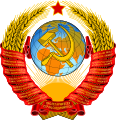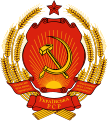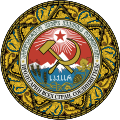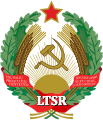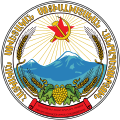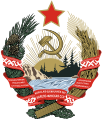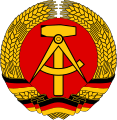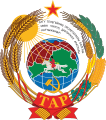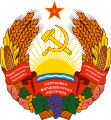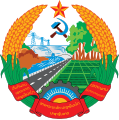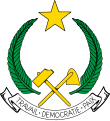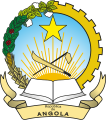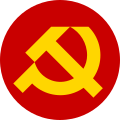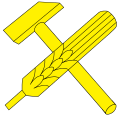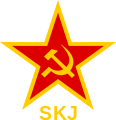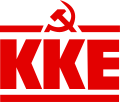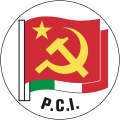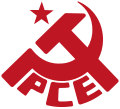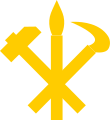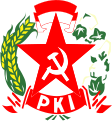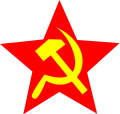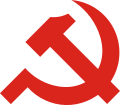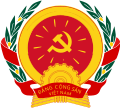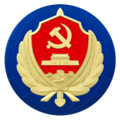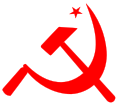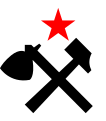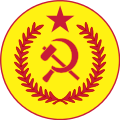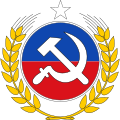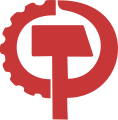Hammer and sickle

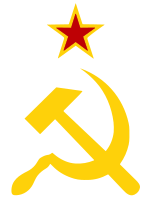
Thehammer and sickle(Unicode:U+262D☭HAMMER AND SICKLE) is acommunist symbolrepresentingproletariansolidarity betweenagriculturalandindustrialworkers. It was first adopted during theRussian Revolutionat the end ofWorld War I,thehammerrepresenting workers and thesicklerepresenting the peasants.[1]
AfterWorld War I(from which Russiawithdrewin 1917) and theRussian Civil War,the hammer and sickle became more widely used as a symbol for labor within theSoviet Union(USSR) and forinternational proletarian unity.It was taken up by manycommunist movementsaround the world, some with local variations. The hammer and sickle remains commonplace in self-declared socialist states, such asChina,Cuba,North Korea,Laos,andVietnam,but also someformer Soviet republicsfollowing thedissolution of the Soviet Union,such asBelarusandRussia.Some countries have imposedbans on communist symbols,where the display of hammer and sickle is prohibited.
History[edit]
Inception[edit]
In 1918,Yevgeny Ivanovich Kamzolkinproposed a 'hammer and sickle' symbol as a decoration for theMay Daycelebrations in theZamoskvorechye DistrictofMoscow.[2][3]It originally featured a sword, but Lenin strongly objected, disliking the militaristic connotations.[4][5]On 6 July 1923, the 2nd session of theCentral Executive Committee(CIK) adopted the emblem.[4][failed verification]
In his work,Daily Life in a Crumbling Empire: The Absorption of Russia into the World Economy,sociologist David Lempert hypothesizes that the hammer and sickle was a secular replacement for thepatriarchal cross.[6][7]
Use in Soviet Union[edit]

- TheState Emblem of the Soviet Unionand theCoats of Arms of the Soviet Republicsshowed the hammer and sickle, which also appeared on thered starbadge on the uniform cap of theRed Armyuniform and in many other places.
- Serp i Molot(transliterationofRussian:cерп и молот,"sickle and hammer" ) is the name of theMoscow Metallurgical Plant.
- Serp i Molotis also the name of a stop on theelectric railwayline from Kurskirailway stationinMoscowtoGorky,featured inVenedikt Yerofeyev's novel,Moscow-Petushki.
Meaning[edit]
At the time of creation, the hammer and sickle stood for worker-peasant alliance, with the hammer a traditional symbol of the industrial proletariat (who dominated the proletariat of Russia) and the sickle a traditional symbol for the peasantry, but the meaning has since broadened to a globally recognizable symbol forMarxism,communist parties,orsocialist states.[4]
Current usage[edit]
Post-Soviet states[edit]
Two federal subjects of the post-Soviet Russian Federation use the hammer and sickle in their symbols: theVladimir Oblasthas them on its flag and theBryansk Oblasthas them on its flag and coat of arms, which is also the central element of its flag. In addition, the Russian city ofOryolalso uses the hammer and sickle on its flag.[citation needed]
The former Soviet (now Russian) national airline,Aeroflot,continues to use the hammer and sickle in its symbol.[8]
Thede factogovernment ofTransnistriauses (with minor modifications) the flag and the emblem of the formerMoldavian SSR,which includes the hammer and sickle. The flag can also appear without the hammer and sickle in some circumstances, for example on Transnistrian-issuedlicense plates.[citation needed]
Communist parties[edit]
Three out of the five currently ruling Communist parties use a hammer and sickle as the party symbol: theChinese Communist Party,theCommunist Party of Vietnamand theLao People's Revolutionary Party.In Laos and Vietnam, the hammer and sickle party flags can often be seen flying side by side with their respective national flags.[citation needed]
Many communist parties around the world also use it, including theCommunist Party of Greece,[9]theCommunist Party of Chile,both theCommunist Party of Braziland theBrazilian Communist Party,thePurba Banglar Sarbahara Partyfrom Bangladesh, theCommunist Party of Sri Lanka,theCommunist Party of India (Marxist),theCommunist Party of India (Marxist–Leninist) Liberation,theCommunist Party of India,theCommunist Party of India (Maoist),the IndianCommunist Marxist Party,theSocialist Unity Centre of India (Communist),theEgyptian Communist Party,theCommunist Party of Pakistan,theCommunist Refoundation Partyin Italy, theCommunist Party of Spain,theCommunist Party of Denmark,theCommunist Party of Norway,theRomanian Communist Party,theLebanese Communist Party,theCommunist Party of the Philippinesand theShining Path.TheCommunist Party of Sweden,thePortuguese Communist Party[10]and theMexican Communist Partyuse the hammer and sickle imposed on the red star.
Variations[edit]
Many symbols having similar structures and messages to the original have been designed. For example, theAngolan flagshows a segment of acog,crossed by amacheteand crowned with asocialist starwhile theflag of Mozambiquefeatures anAKMcrossed by ahoe.In the logo of theCommunist Party USA,a circle is formed by a half cog and asemicircularsickle-blade. A hammer is laid directly over the sickle's handle with the hammer'sheadat the logo's center. The logo of theCommunist Party of Turkeyconsists of half a cog wheel crossed by a hammer, with a star on the top.[citation needed]
Tools represented in other designs include: thebrush,sickle and hammer of theWorkers' Party of Korea;thespade,flaming torchandquillused prior to 1984 by the BritishLabour Party;thepickaxeandrifleused incommunist Albania;and the hammer andcompassesof theEast Germanemblem and flag. TheFar Eastern Republicof Russia used ananchorcrossed over a spade or pickaxe, symbolising the union of the fishermen and miners. TheFourth International,founded byLeon Trotsky,uses a hammer and sickle symbol on which the number 4 is superimposed. The hammer and sickle in the Fourth International symbol are the opposite of other hammer and sickle symbols in that the head of the hammer is on the right side and the sickle end tip on the left. TheTrotskyistLeague for the Fifth Internationalmerges a hammer with the number 5, using the number's lower arch to form the sickle. A sickle with a rifle is also used by thePeople's Mojahedin of Iran.[citation needed]
TheCommunist Party of Britainuses the hammer anddove symbol.Designed in 1988 by Michal Boncza, it is intended to highlight the party's connection to the peace movement. It is usually used in conjunction with the hammer and sickle and it appears on all of the CPB's publications. Some members of the CPB prefer one symbol over the other, although the party's 1994 congress reaffirmed the hammer and dove's position as the official emblem of the party. Similarly, theCommunist Party of Israeluses a dove over the hammer and sickle as its symbol. The flag of theGuadeloupe Communist Partyuses a sickle, turned to look like amajuscule G,to representGuadeloupe.[11]
In 1938, theDobama Asiayone,an anti-British nationalist group in the thenBritish Burma,adopted a tricolour flag charged with red sickle and hammer.[12]From 1974–2010, theflag of Burma (Myanmar)featured a bushel ofricesuperimposed on acogwheelsurrounded by fourteen white stars; the rice representing the peasants and the cogwheel representing the workers, the combination symbolizing that the peasants and workers be the two basic social classes for State building, while the fourteen equal-sized white stars indicate the unity and equality of fourteenmember statesof the Union.[13]
The flag ofChama Cha Mapinduzi(CCM, Party of the Revolution inSwahili), currently the ruling political party ofTanzania,has a slightly different symbol with a hammer and ahoe(jembe) instead of a sickle to represent the most common farm tool in Africa.[citation needed]
The symbols of theliberal socialistparties ofRadical Civic UnioninArgentinaand theCzech National Social Partyin the Czech Republic features a hammer and a quill with the former representing workers and the latter representing clerks.[citation needed]
The election symbol ofCommunist Party of Indiaconsists of a horizontal sickle, vertically crossed byEars of Cornin the center.
Art[edit]
The hammer and sickle has long been a common theme in socialist realism, but it has also seen some depiction in non-Marxist popular culture.Andy Warholwho created many drawings and photographs of the hammer and sickle is the most famous example of this.
-
The metro station,Plošča Lienina,Minsk
-
Sándor Pinczehelyi,Hammer and Sickle
-
The Hoof and Horn flag described in the bookAnimal Farmis a parody of the hammer and sickle.
Legal status[edit]
In several countries in the formerEastern Bloc,there are laws that define the hammer and sickle as the symbol of a "totalitarianand criminal ideology "and the public display of the hammer and sickle and other Communist symbols such as the red star is considered a criminal offence.Georgia,[14]Hungary,[15]Latvia,[16]Lithuania,[17]Moldova(1 October 2012 – 4 June 2013)[18]andUkraine[19][20][21]havebanned communist symbolsincluding this one. A similar law was considered inEstonia,[22]but it eventually failed in a parliamentary committee.[23]In Ukraine, the legislature equals communist symbols including hammer with sickle to Naziswastikasymbols.[24][25]
In 2010, theLithuanian,Latvian,Bulgarian,Hungarian,Romanian,andCzechgovernments called for the European Union to criminalize "the approval, denial or belittling of communist crimes" similar to how a number of EU member states have bannedHolocaust denial.TheEuropean Commissionturned down this request, finding after a study that the criteria for EU-wide criminal legislation were not met, leaving individual member states to determine the extent to which they wished to handle past totalitarian crimes.[26]
In February 2013, theConstitutional Court of Hungaryannulled the ban on the use of symbols of fascist and communist dictatorships, including the hammer and sickle, the red star and the swastika, saying the ban was too broad and imprecise. The court also pointed to a judgement of theEuropean Court of Human Rightsin which Hungary was found guilty of violation ofarticle 10,the right tofreedom of expression.[27]In June 2013, theConstitutional Court of Moldovaruled that theMoldovan Communist Party's symbols—the hammer and sickle—are legal and can be used.[28]
InIndonesia,the display of communist symbols is banned and the country'sCommunist partywas also banned by decree of presidentSuharto,following the1965–1966 killings of communistsin which over 500,000 people were killed.[29][30]In January 2018, an activist protesting againstBumi Resourcesdisplayed the hammer and sickle, was accused of spreading communism, and later jailed.[31][32]
InPoland,dissemination of items which are "media of fascist, communist or other totalitarian symbolism" was criminalized in 1997. However, theConstitutional Tribunalfound this sanction to be unconstitutional in 2011.[33]
Usage[edit]
Flags[edit]
Europe and Russia/Soviet Union[edit]
-
Flag of the Soviet Unionfrom 1922 to 1923
-
Flag of the Soviet Union from 1924
-
Flag of the Soviet Union from 1924 to 1936
-
Flag of the Soviet Union from 1936 to 1955
-
Flag of the Soviet Union from 19 August 1955 to 26 December 1991
-
Naval Jack of the Soviet UnionandRussiafrom 16 November 1950 to 26 July 1992
-
Naval ensign of the Soviet Unionand Russia from 16 November 1950 to 26 July 1992
-
Flag ofAeroflotfrom 1961 to 1991
-
Flag of theRussian SFSRfrom 1954 to 1991
-
Flag of theUkrainian SSRfrom 1950 to 1992
-
Flag of theByelorussian SSRfrom 1951 to 1991
-
Flag of theUzbek SSRfrom 1952 to 1991
-
Flag of theKazakh SSRfrom 1953 to 1992
-
Flag of theGeorgian SSRfrom 1951 to 1990
-
Flag of theAzerbaijani SSRfrom 1956 to 1991
-
Flag of theLithuanian SSRfrom 1953 to 1988
-
Flag of theMoldavian SSRfrom 1952 to 1990
-
Flag of theLatvian SSRfrom 1953 to 1990
-
Flag of theKirghiz SSRfrom 1952 to 1992
-
Flag of theTajik SSRfrom 1953 to 1991
-
Flag of theArmenian SSRfrom 1952 to 1990
-
Flag of theTurkmen SSRfrom 1953 to 1992
-
Flag of theEstonian SSRfrom 1953 to 1990
-
Flag of theKarelo-Finnish SSRfrom 1953 to 1956
-
Flag of theRomanian Communist Party
-
Flag of theCommunist Party of the Russian Federation
-
Flag of theCommunists of Russia
-
Flag ofBryansk Oblast(Russia)
-
Flag ofVladimir Oblast(Russia)
-
Flag ofOryol(Russia)
-
Flag ofTransnistria(Moldova)
-
Flag of the National Bolshevik Party
-
Flag of theCommunist Party of Germany
-
Reverse side of the Communist Party of Germany flag
-
Flag ofEast Germanyfrom 1959 to 1990
-
Flag of theCommunist Party of Greece
-
Flag of theItalian Communist Party
-
Flag of theCommunist Refoundation Party(Italy)
-
Flag of theCommunist Party of Ireland
-
Flag of thePortuguese Communist Party
-
Flag of theSammarinese Communist Party
-
Flag of theMaoist Communist Party (Turkey)
-
Flag of theRevolutionary People's Liberation Party–Front(Turkey)
-
Flag of theCommunist Party of Britain
-
Flag of theLeague of Communists of Yugoslavia
Asia minus Russia/Soviet Union[edit]
-
Flag of theVietnamese Communist Party
-
Flag of theChinese Communist Party
-
Flag of theChinese Communist Party(before 1996)
-
Flag of theTaiwan Democratic Communist Party
-
Flag of theChinese Soviet Republic(1931–1937)
-
Flag of theWorkers' Party of Korea
-
Flag of theCommunist Party of India
-
Flag of theCommunist Party of India (Marxist)
-
Flag of various South Asian communist parties, including theCommunist Party of India (Maoist)
-
Flag of theSocialist Unity Centre of India
-
Flag of theCommunist Party of Bangladesh
-
Flag of theNepal Communist Party
-
Flag ofCommunist Party of Indonesia
-
Flag of theSocialist Party of Timor
-
Flag of theCommunist Party of the Philippines
-
Flag of theLao People's Revolutionary Party
-
Flag of theCommunist Party of Kampuchea
-
Flag of theMalayan Communist Party(1930–1989)
-
Flag of theLebanese Communist Party
-
Flag of theSyrian Communist Party (Bakdash)
-
Flag of theKurdistan Workers' Party(1978–1995)
-
Flag of theJordanian Communist Party
-
Flag of thePalestinian Communist Party
Africa[edit]
-
Flag of theAlgerian Communist Party
-
Flag ofFRELIMO(1987–2004)
-
Flag of thePeople's Republic of the Congoand theCongolese Party of Labour
-
Flag of theWorkers' Party of Ethiopia
-
Flag of theCommunist Party of Kenya
-
Flag of theSouth African Communist Party
-
Flag of theCommunist Party of Swaziland
Americas[edit]
-
Flag of thePCCE
-
Flag of thePCdoB
-
Flag of theWorkers' Cause Party(Brazil)
-
Flag of theCommunist Party of Chile
-
Flag of theCommunist Party of Ecuador
-
Flag of theShining Path(Peru)
-
Flag of theCommunist Party USA
-
Flag of theRevolutionary Communist Party(Argentina)
State emblems[edit]
Soviet Union (in the constitutional order)[edit]
-
Emblemof theRussian Federation(1992‒1993)
Other[edit]
-
National emblemof theGerman Democratic Republic(1955–1990)
-
State emblemof theTuvan People's Republic(1943‒1944)
-
Emblemof the self-proclaimedPridnestrovian Moldavian Republic
-
State emblemof theLao People's Democratic Republic(1975‒1991)
-
Emblem of thePeople's Republic of the Congo(1970–1991)
-
State emblemof theChinese Soviet Republic(1934–1937)
-
Emblem ofHungarian People's Republic(1949–1956)
-
Emblem ofMoscow(1924–1937)
Logos[edit]
Europe[edit]
-
The hammer and sickle symbol used with thered starused as a symbol ofSoviet Union.
-
Badge of theCommunist Party of the Soviet Union
-
Emblem of theCommunist Party of Czechoslovakia
-
Emblem of theRomanian Communist Party
-
Logo of theBulgarian Communist Party
-
Compass and hammer ofEast Germany.
-
Hammer and grain of theHungarian People's Republic
-
Emblem of theLeague of Communists of Yugoslavia
-
Logo of theCommunist Party of the Russian Federation
-
Logo of theCommunist Party of Greece
-
Logo of theItalian Communist Party
-
Logo of theProletarian Unity Party (Italy)
-
Logo of theCommunist Party (Italy)
-
Logo of theCommunist Party of Spain
-
Logo of theCommunist Party of the Peoples of Spain
-
Logo of thePortuguese Communist Party
-
Logo of theCommunist Party of Ireland
-
Logo of theFrench Communist Party(1980‒1996)
-
Logo of theCommunist Party of Britain
-
Logo of theCommunist Party (Sweden)
-
The Logo of theCommunist Party of Norway
-
Logo of theCommunist Party of Denmark
-
Logo of theCommunist Party (Denmark)
-
Logo of theCommunist Party of Germany
-
Logo of theCommunist Party (Switzerland)
-
Logo of theNew Communist Party of the Netherlands
-
Logo of theCommunist Party of Belgium (1989)
-
Badge of theMarxist–Leninist Communist Party of Turkey
-
Logo of theRevolutionary Communist Party of Turkey
-
Logo ofAeroflot
-
Symbol of theGroup of Social Revolutionary Nationalists
Asia[edit]
-
Emblem of theWorkers' Party of Korea
-
Emblem of theCommunist Party of Indonesia(1914‒1966)
-
Logo of theAcoma Party(Indonesia)
-
Logo of theCommunist Party of Tajikistan
-
Logo of theSocialist Party of Bangladesh
-
Logo of the Communist Party of Nepal (Unified Marxist–Leninist) (1991–2018)
-
Emblem of theCommunist Party of Vietnam
-
Alternative emblem of theCommunist Party of Vietnam
-
Logo of theMinistry of State Security
-
Emblem of the Chinese Communist Party(1942–1996)
-
Emblem of the Chinese Communist Party (1996–present)
-
Logo of theLanka Sama Samaja Party,which features the symbol of theFourth International
-
Logo of theCommunist Party of India
-
Logo of theCommunist Party of India (Marxist)
Africa[edit]
-
Cogwheel, machete and star logo ofAngola
-
Logo of theCommunist Party of Benin
-
Logo of theCongolese Party of Labour
-
Logo of theEgyptian Communist Party
-
Flag of theWorkers' Party of Ethiopia
-
Emblem of theAll-Ethiopia Socialist Movement
-
Emblem of theEthiopian People's Revolutionary Party(ca. 1975)
-
Logo of theRevolutionary Communist Party of Ivory Coast
-
Logo of theCommunist Party of Kenya
-
Logo ofFRELIMO(Mozambique) (1987–2004)
-
Emblem of theSomali Revolutionary Socialist Party
-
Logo of theSouth African Communist Party
-
Logo of theWorkers' Party of Tunisia
Americas[edit]
-
Logo of theCommunist Party of Argentina
-
Logo of theBrazilian Communist Party
-
Logo of theCommunist Party of Brazil
-
Logo of theWorkers' Cause Party
-
Logo of theCommunist Party of Chile
-
Logo of theCommunist Party of Ecuador
-
Logo of theMexican Communist Party
-
Logo of theParaguayan Communist Party
-
Logo of theShining Path
-
Emblem of theCommunist Party USA
Unicode[edit]
InUnicode,the "hammer and sickle" symbol is U+262D (☭). It is part of theMiscellaneous Symbols(2600–26FF) code block. It was added to Unicode 1.1 in 1993.[34]
See also[edit]
- Arm and hammer
- Fist and rose
- Communist symbolism
- Socialist heraldry
- Hammer and pick(⚒)
- Red flag(⚑)
- Red star(★)
- Transport and Map SymbolsUnicode block (contains🛠"hammer and wrench" as U+1F6E0)
Notes[edit]
References[edit]
- ^"Flag of Union of Soviet Socialist Republics".Encyclopedia Britannica.Retrieved30 November2019.
- ^"АртРу.инфо - Художники - Камзолкин Евгений Иванович".Artru.info.18 March 1957. Archived fromthe originalon 4 March 2016.Retrieved2 January2017.
- ^"International Gallery of Contemporary Artists".Archived fromthe originalon 16 August 2016.Retrieved6 November2015.
- ^abcWharton, Christopher."The Hammer and Sickle: The Role of Symbolism and Rituals in the Russian Revolution".The Myriad: Westminster's Interactive Academic Journal.Archived fromthe originalon 10 August 2014.Retrieved1 September2023.
- ^Stites, Richard (1997)."The Role of Ritual and Symbols".In Acton, Edward; Cherniaev, Vladimir Iu.; Rosenberg, William G. (eds.).Critical companion to the Russian Revolution, 1914-1921.Indiana University Press. pp. 568–569.ISBN978-0-253-33333-9.
- ^Lempert, David (1996).Daily Life in a Crumbling Empire: The Absorption of Russia into the World Economy.Columbia University Press/ Eastern European Monographs.ISBN0-880-33341-3.
- ^Crangan, Costel (1 September 2018)."De unde vine simbolul" secera şi ciocanul ". Ce ţară l-a folosit prima şi în ce state este interzis"[Where does the symbol "sickle and hammer" come from? Which country used it first and in which states it is forbidden] (in Romanian). Adevarul Holding.
- ^"Aeroflot Logo To Keep Hammer And Sickle".aviationweek.18 April 2003.Retrieved16 September2022.
- ^"KKE - Αρχική".kke.gr.
- ^"Estatutos do PCP, art. 72".pcp.pt/estatutos-do-pcp.17 March 2010.
- ^"Parti Communiste Guadeloupéen".flagspot.net.
- ^Khin Yi (1988).The Dobama Movement in Burma (1930-1938).Cornell University Press. p. 39.
- ^မြန်မာဖတ်စာ ဒုတိယတန်း (Grade-3)[Myanmar Textbook for Second Standard (Grade-3)] (in Burmese). Ministry of Education, Government of the Union of Myanmar. 2006. p. 1.
- ^Communist symbols to be banned in Georgia,BBC News,4 May 2014,retrieved13 May2014
- ^"Act C of 2012 on the Criminal Code, Section 335: Use of Symbols of Totalitarianism"(PDF).Ministry of Interior of Hungary.p. 97.Retrieved21 February2017.
Any person who: a) distributes, b) uses before the public at large, or c) publicly exhibits, the swastika, the insignia of the SS, the arrow cross, the sickle and hammer, the five-pointed red star or any symbol depicting the above so as to breach public peace – specifically in a way to offend the dignity of victims of totalitarian regimes and their right to sanctity – is guilty of a misdemeanor punishable by custodial arrest, insofar as they did not result in a more serious criminal offense.
- ^Latvia Bans Soviet, Nazi Symbols,RIA Novosti, 21 June 2013,retrieved14 September2014
- ^"Lithuanian ban on Soviet symbols".BBC News.17 June 2008.
- ^"Moldovan Parliament Bans Communist Symbols".Radio Free Europe.12 July 2012.
- ^"Ukraine Bans Soviet-Era Symbols".The Wall Street Journal.
- ^LAW OF UKRAINE. On the condemnation of the communist and national socialist (Nazi) regimes, and prohibition of propaganda of their symbols
- ^"Про засудження комуністичного та націонал-соціалістичного... - від 09.04.2015 № 317-VIII".rada.gov.ua.
- ^"Free speech questioned as Estonia prepares to ban Soviet, Nazi symbols".
- ^"Ants Erm: Erinevalt venelaste ajaloost on Venemaa ajalugu Eestis vaid vägivald, küüditamine ja kommunistlik diktatuur".
- ^"У поліції нагадали, що за серп і молот можна сісти на 5 років".Українська правда(in Ukrainian).Retrieved5 July2022.
- ^Bobkov, Denys (7 May 2021)."Заборона символіки тоталітарних режимів: що мають знати миколаївці".
- ^EU won't legislate on communist crimes,BBC News (22 December 2010).
- ^"Hungary, hammer and sickle ban declared illegal".ANSA.27 February 2013.Retrieved12 November2013.
- ^"Constitutional Court rules that 'hammer and sickle' can be used".allmoldova.5 June 2013. Archived fromthe originalon 12 November 2013.Retrieved12 November2013.
- ^"Declassified files outline US support for 1965 Indonesia massacre".archive.is.29 October 2017. Archived fromthe originalon 29 October 2017.Retrieved16 February2019.
- ^Dickie Christanto (20 October 2008)."Artists summoned over communist symbol exhibition".The Jakarta Post.Archived fromthe originalon 26 October 2008.Retrieved12 November2013.
- ^"Indonesian activist jailed for advocating communism".ucanews.Retrieved16 February2019.
- ^"Indonesia's 'Anti-Communism' Law Used Against Environmental Activist".Human Rights Watch.12 January 2018.Retrieved21 July2021.
- ^"Nowelizacja kodeksu karnego"(in Polish). 19 July 2011.Retrieved8 April2015.
- ^"☭ Hammer and Sickle Emoji".emojipedia.org.Retrieved11 October2019.
External links[edit]
 Media related toHammer and sickleat Wikimedia Commons
Media related toHammer and sickleat Wikimedia Commons Media related toHammer and sickle in heraldryat Wikimedia Commons
Media related toHammer and sickle in heraldryat Wikimedia Commons
- Hammer and sickle
- Heraldic charges
- National symbols of Armenia
- National symbols of Azerbaijan
- National symbols of Belarus
- National symbols of Georgia (country)
- National symbols of Kazakhstan
- National symbols of Kyrgyzstan
- National symbols of Laos
- National symbols of Moldova
- National symbols of Russia
- National symbols of Tajikistan
- National symbols of the People's Republic of China
- National symbols of the Soviet Union
- National symbols of Turkmenistan
- National symbols of Ukraine
- National symbols of Uzbekistan
- Symbols of communism































































































